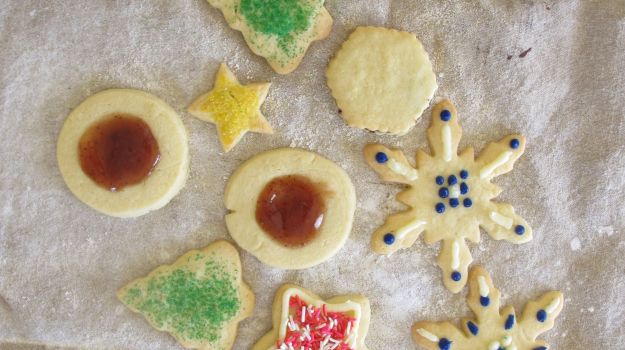Sugar cookies are as essential to the Christmas season as lighted trees, wrapping paper and "Jingle Bells." While there are as many varieties of holiday cookies as there are Christmas carols -- from Linzer cookies to Mexican wedding cookies -- I am talking here strictly about decorated sugar cookies.
I grew up with one grandmother in Boston and the other in Buffalo, New York. Their sugar cookies were as different as those two cities. My New England grandmother's were extra buttery and lightly baked, almost shortbread-like; my New York state grandmother's version was chewier and baked to a golden brown. Both were washed with egg white and showered with colored sprinkles before baking. I devoured both kinds with equal abandon.
How can there be so much variation in something as simple as a sugar cookie? This question hit me at a holiday party last year, when several friends brought their families' versions of this holiday classic. As I tasted each one, the cookies were as distinct as snowflakes.
Sugar cookie dough basics
When it comes to sugar cookie recipes, the ingredients are universal: flour, baking powder or baking soda, butter, sugar, egg and vanilla (and sometimes milk). So, what causes all the variability?
I gathered a collection of five time-tested recipes and analyzed them. The biggest difference? Ratios, in baker's terms, or the proportions of the three main ingredients: flour, butter and sugar. These ingredients are the "structural" elements of the cookies, and the ratio of each building block is what makes each cookie unique.
The biggest determinant of taste and texture is the ratio of butter to flour. Among the five recipes, the highest butter percentage was more than 50% of the flour and the lowest came in at just more than 30%. The quantity of sugar also varied wildly from recipe to recipe; the most astonishing example was two recipes that each contained three cups of flour, but one of the recipes called for three times as much sugar as the other (1 1/2 cups compared with 1/2 cup). Any of these ratios largely affect whether cookies turn out cakier, chewier or more crumbly. Interestingly, all the other ingredient ratios, from eggs to baking powder, were more consistent across the board. But each minor change can result in such subtle differences as the flavor of salt or vanilla in the baked cookie. You can't know it until you taste it.
Baking know-how
The baker, too, introduces variability in such simple recipes as this, especially through measuring and mixing techniques. For example, there are two methods for measuring flour: scoop and sweep or dip. The scoop-and-sweep method has become a standard for recipe writers because it is more consistent. The "dip" method can often pack down the flour too much. Nowadays, more recipes include weights, encouraging bakers to use digital scales, which are more precise and eliminate the need for measuring cups altogether.

Similarly, during the mixing, many bakers falter in the first step of creaming the butter with the sugar. When mixed long enough -- about 3 minutes at medium speed in a stand mixer -- the butter aerates while the sugar creates the air pockets that the action of the baking powder or soda enlarge to produce the lightest baked treats.
Butter temperature is a third potential pitfall in sugar cookie production. The ideal is room temperature butter -- spreadable but still solid, preserving the emulsion of water with butterfat. When it is too cold or too warm, the butter cannot aerate properly to give the dough good structure. The right temperature is also important for shaping and baking, so chilling the dough both after mixing and after cutting shapes makes the best-looking cookies.
All-around cookie dough
After I tested the five recipes and sampled them side by side with an open mind, I discovered that there is no such thing as a dud sugar cookie. The truth is, the ultimate sugar cookie is the one you like best, whether the recipe is from your grandmother, the local paper or Food52.
What truly makes the sugar cookie a standout -- apart from its wonderful simplicity -- is the fact that it is the most multitasking cookie of all. With one dough in your repertoire, it's possible to craft a whole dessert tray worth of distinct Christmas cookies.
Other than using sugar cookie dough for rolled and cut cookies, you can also shape it into sandwich cookies, thumbprints, bars or even slice-and-bake cookies from your freezer. You can flavor the dough with lemon or orange zest, spices like cardamom or nutmeg or almond flavoring -- all to your taste. Or, mix in chopped nuts, dark chocolate or crystallized ginger.
When it comes to decorating cut-out sugar cookies, there are two camps: the sprinklers and the frosters. I am firmly in the colored sprinkles camp, both because of my Christmas cookie heritage and because I find most frostings make the whole endeavor too sweet.
No matter the recipe, the true goal is to celebrate the stellar pleasures of the sugar cookie that come but once a year.By Lynne Curry (Zester Daily) -© Thomson Reuters 2015







